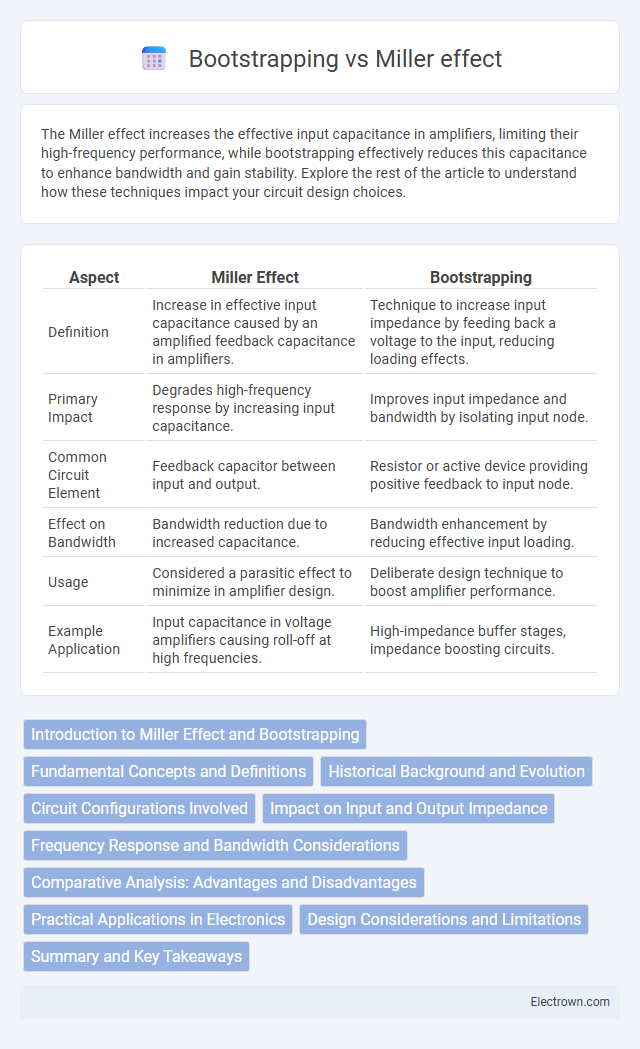The Miller effect increases the effective input capacitance in amplifiers, limiting their high-frequency performance, while bootstrapping effectively reduces this capacitance to enhance bandwidth and gain stability. Explore the rest of the article to understand how these techniques impact your circuit design choices.
Table of Comparison
| Aspect | Miller Effect | Bootstrapping |
|---|---|---|
| Definition | Increase in effective input capacitance caused by an amplified feedback capacitance in amplifiers. | Technique to increase input impedance by feeding back a voltage to the input, reducing loading effects. |
| Primary Impact | Degrades high-frequency response by increasing input capacitance. | Improves input impedance and bandwidth by isolating input node. |
| Common Circuit Element | Feedback capacitor between input and output. | Resistor or active device providing positive feedback to input node. |
| Effect on Bandwidth | Bandwidth reduction due to increased capacitance. | Bandwidth enhancement by reducing effective input loading. |
| Usage | Considered a parasitic effect to minimize in amplifier design. | Deliberate design technique to boost amplifier performance. |
| Example Application | Input capacitance in voltage amplifiers causing roll-off at high frequencies. | High-impedance buffer stages, impedance boosting circuits. |
Introduction to Miller Effect and Bootstrapping
The Miller Effect describes how a capacitance connected between the input and output of an amplifier is multiplied, significantly impacting high-frequency response in circuits. Bootstrapping is a technique used to reduce the Miller capacitance by maintaining the voltage across the capacitor constant, thereby enhancing the bandwidth. Understanding these concepts is essential for optimizing your amplifier's frequency performance.
Fundamental Concepts and Definitions
The Miller effect describes the apparent increase in input capacitance of an amplifier due to feedback through a gain stage, significantly impacting high-frequency response. Bootstrapping, on the other hand, involves supplying a voltage to a component in a way that effectively cancels or reduces its inherent capacitance, improving bandwidth by maintaining a constant voltage across the capacitor. Understanding these fundamental concepts helps You optimize amplifier design for enhanced frequency performance and stability.
Historical Background and Evolution
The Miller effect, first explained by John Milton Miller in 1920, highlights the amplification of input capacitance in amplifiers due to feedback, critically impacting high-frequency circuit design. Bootstrapping emerged later as a technique to counteract the Miller effect by increasing input impedance, thus reducing the effective capacitance and enhancing bandwidth. Both concepts have evolved alongside transistor technology advancements, shaping modern analog circuit performance and stability.
Circuit Configurations Involved
The Miller effect primarily occurs in common-emitter and common-source amplifier configurations, where the input-to-output capacitance is multiplied by the gain, increasing effective input capacitance and reducing bandwidth. Bootstrapping techniques are often implemented in emitter-follower or source-follower circuits to increase input impedance by feeding back a portion of the output signal to the input node, effectively neutralizing parasitic capacitances. Both methods directly influence high-frequency performance but rely on distinct circuit topologies tailored for impedance and capacitance management.
Impact on Input and Output Impedance
The Miller effect increases the effective input capacitance of an amplifier, significantly lowering the input impedance and limiting high-frequency response. Bootstrapping, by contrast, reduces the voltage across the input capacitance, effectively increasing input impedance and improving bandwidth. While the Miller effect decreases output impedance due to feedback, bootstrapping maintains or slightly increases output impedance by isolating parasitic capacitances.
Frequency Response and Bandwidth Considerations
The Miller effect significantly reduces bandwidth by increasing the effective input capacitance, which lowers the high-frequency response in amplifier circuits. In contrast, bootstrapping techniques minimize this capacitance's impact, enhancing frequency response and extending bandwidth by maintaining a nearly constant voltage across the input capacitor. Your choice between these methods depends on the desired trade-off between gain, bandwidth, and stability in high-frequency applications.
Comparative Analysis: Advantages and Disadvantages
The Miller effect significantly increases the effective input capacitance in high-frequency amplifiers, leading to reduced bandwidth and potential instability, whereas bootstrapping minimizes this effect by effectively isolating the input capacitance, thereby enhancing frequency response. Miller effect circuits tend to be simpler but suffer from gain-bandwidth trade-offs, while bootstrapping adds complexity and additional components but offers improved linearity and higher gain at high frequencies. Understanding these trade-offs helps you design amplifiers that balance stability, bandwidth, and complexity based on your specific application needs.
Practical Applications in Electronics
Miller effect significantly impacts amplifier frequency response by increasing input capacitance, which can limit high-frequency performance in practical electronic designs. Bootstrapping techniques counteract this by using feedback to effectively reduce input capacitance, enhancing bandwidth and overall stability in circuits such as operational amplifiers and analog signal processing. Your choice between addressing Miller effect or employing bootstrapping depends on the specific high-frequency requirements and the desired gain stability in electronic applications.
Design Considerations and Limitations
Miller effect significantly influences high-frequency amplifier design by increasing the effective input capacitance, which can limit bandwidth and slow response times, requiring careful compensation techniques. Bootstrapping improves input impedance and bandwidth by effectively reducing the input capacitance, but it demands precise biasing and can introduce stability challenges in your circuit. Both methods require a trade-off between gain, bandwidth, and stability, making it critical to evaluate the specific application requirements during design optimization.
Summary and Key Takeaways
The Miller effect refers to the multiplication of an input capacitance due to gain in an amplifier, significantly impacting high-frequency response by increasing the effective capacitance seen at the input. Bootstrapping techniques counteract this effect by using feedback to keep the voltage across the input capacitance constant, effectively reducing the input capacitance and improving bandwidth. Understanding this balance helps you optimize circuit performance, especially in high-speed analog designs where input capacitance is critical.
Miller effect vs bootstrapping Infographic

 electrown.com
electrown.com